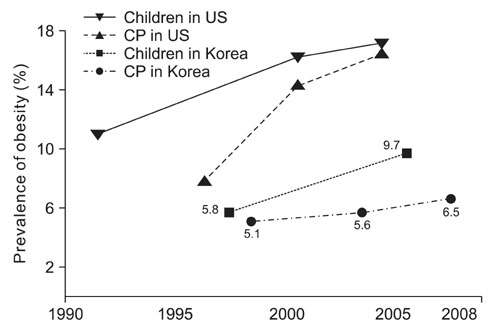Clin Orthop Surg.
2011 Sep;3(3):211-216. 10.4055/cios.2011.3.3.211.
Prevalence of Obesity in Ambulatory Patients with Cerebral Palsy in the Korean Population: A Single Institution's Experience
- Affiliations
-
- 1Department of Orthopedic Surgery, Inha University School of Medicine, Incheon, Korea.
- 2Department of Orthopedic Surgery, Seoul National University Children's Hospital, Seoul, Korea.
- 3Department of Orthopedic Surgery, Seoul National University Bundang Hospital, Seongnam, Korea.
- 4Department of Orthopedic Surgery, Dongguk University Ilsan Hospital, Dongguk University College of Medicine, Goyang, Korea. drlsh@hanmail.net
- KMID: 1743911
- DOI: http://doi.org/10.4055/cios.2011.3.3.211
Abstract
- BACKGROUND
There is a worldwide tendency of an increasing prevalence of obesity. Therefore, this study aimed at determining whether such a trend exists among cerebral palsy (CP) patients. We also tried to compare this trend with the trend in the general population. We also discuss the importance of obesity trends in CP patients.
METHODS
This retrospective study was performed on 766 ambulatory patients who were diagnosed with CP since 1996 in our institution. The associations among the prevalence of obesity and the body mass index, age, gender, the type of CP, the gross motor function classification system and the time of survey were investigated.
RESULTS
The overall prevalence of obesity was 5.7%, and the overall prevalence of obesity together with being overweight was 14.6% for the ambulatory patients with CP. The prevalence of obesity and of obesity together with being overweight did not show a statistically significant temporal increase. On the other hand, age and gender were found to affect the body mass index of the ambulatory CP patients (p < 0.001 and 0.003, respectively).
CONCLUSIONS
The extent of obesity and being overweight in the ambulatory patients with CP in this study was far less than that reported in the United States (US). In addition, it appears that the differences of the prevalence of obesity in children and adolescents between those with and without CP are disappearing in the US, whereas the differences of the prevalence of obesity in children and adolescents between those with and without CP seem to be becoming more obvious in Korea. Accordingly, care should be taken when adopting the data originating from the US because this data might be affected by the greater prevalence of obesity and the generally higher body mass indices of the US.
MeSH Terms
Figure
Cited by 1 articles
-
Study of the Residential Environment and Accessibility of Rehabilitation for Patients with Cerebral Palsy
Gyeong Hee Cho, Chin Youb Chung, Kyoung Min Lee, Ki Hyuk Sung, Byung Chae Cho, Moon Seok Park
J Korean Orthop Assoc. 2019;54(4):309-316. doi: 10.4055/jkoa.2019.54.4.309.
Reference
-
1. Ebbeling CB, Pawlak DB, Ludwig DS. Childhood obesity: public-health crisis, common sense cure. Lancet. 2002. 360(9331):473–482.
Article2. Oh K, Jang MJ, Lee NY, et al. Prevalence and trends in obesity among Korean children and adolescents in 1997 and 2005. Korean J Pediatr. 2008. 51(9):950–955.
Article3. Ogden CL, Flegal KM, Carroll MD, Johnson CL. Prevalence and trends in overweight among US children and adolescents, 1999-2000. JAMA. 2002. 288(14):1728–1732.
Article4. Hedley AA, Ogden CL, Johnson CL, Carroll MD, Curtin LR, Flegal KM. Prevalence of overweight and obesity among US children, adolescents, and adults, 1999-2002. JAMA. 2004. 291(23):2847–2850.
Article5. Bax M, Goldstein M, Rosenbaum P, et al. Proposed definition and classification of cerebral palsy, April 2005. Dev Med Child Neurol. 2005. 47(8):571–576.
Article6. Rogozinski BM, Davids JR, Davis RB, et al. Prevalence of obesity in ambulatory children with cerebral palsy. J Bone Joint Surg Am. 2007. 89(11):2421–2426.
Article7. Hurvitz EA, Green LB, Hornyak JE, Khurana SR, Koch LG. Body mass index measures in children with cerebral palsy related to gross motor function classification: a clinic-based study. Am J Phys Med Rehabil. 2008. 87(5):395–403.
Article8. Palisano R, Rosenbaum P, Walter S, Russell D, Wood E, Galuppi B. Development and reliability of a system to classify gross motor function in children with cerebral palsy. Dev Med Child Neurol. 1997. 39(4):214–223.
Article9. Cole TJ, Bellizzi MC, Flegal KM, Dietz WH. Establishing a standard definition for child overweight and obesity worldwide: international survey. BMJ. 2000. 320(7244):1240–1243.
Article10. Korea Center for Disease Control and Prevention. The Korean Pediatric Society. The Committee for the Development of Growth Standard for Korean Children and Adolescents. 2007 Korean children and adolescents growth standard (commentary for the development of 2007 growth charts) [Internet]. 2007. cited 2010 Mar 10. Seoul: Division of Chronic Disease Surveillance;Available from: http://www.cdc.go.kr/.11. Taylor ED, Theim KR, Mirch MC, et al. Orthopedic complications of overweight in children and adolescents. Pediatrics. 2006. 117(6):2167–2174.
Article12. Lundberg A. Maximal aerobic capacity of young people with spastic cerebral palsy. Dev Med Child Neurol. 1978. 20(2):205–210.
Article13. Norman AC, Drinkard B, McDuffie JR, Ghorbani S, Yanoff LB, Yanovski JA. Influence of excess adiposity on exercise fitness and performance in overweight children and adolescents. Pediatrics. 2005. 115(6):e690–e696.
Article14. Hills AP, Hennig EM, Byrne NM, Steele JR. The biomechanics of adiposity: structural and functional limitations of obesity and implications for movement. Obes Rev. 2002. 3(1):35–43.
Article15. Gough M, Shafafy R, Shortland AP. Does sex influence outcome in ambulant children with bilateral spastic cerebral palsy? Dev Med Child Neurol. 2008. 50(9):702–705.
Article
- Full Text Links
- Actions
-
Cited
- CITED
-
- Close
- Share
- Similar articles
-
- Prevalence of Cerebral Palsy in Neonates with Risk Factors
- Leg Length Discrepancy in Hemiplegic Cerebral Palsy: Prevalence and 3-Dimensional Gait Analysis
- A Survey of Drooling in Children with Cerebral Palsy
- Prevalences of Neurological Diseases in the Instftutionalized Population
- Effects of Botulinum Toxin A Treatment in Cerebral Palsy




